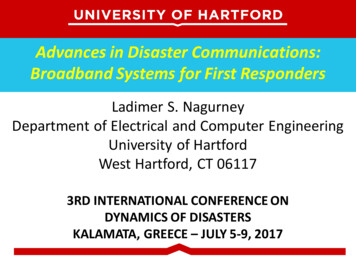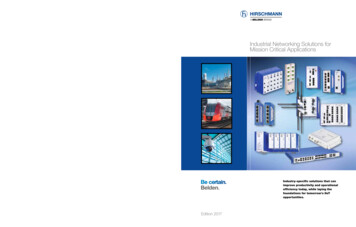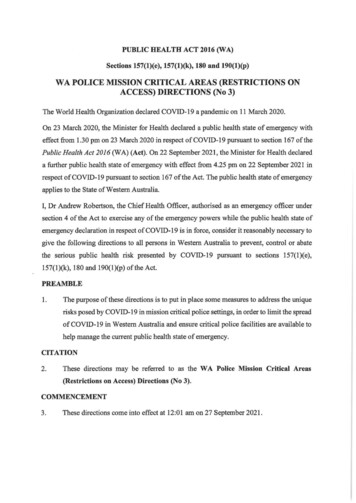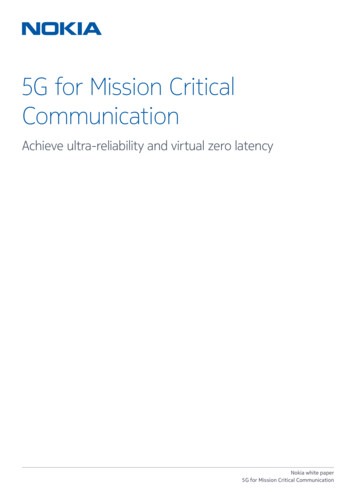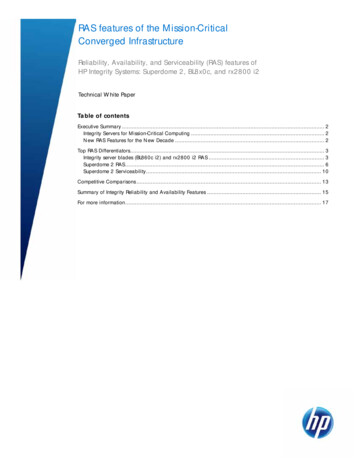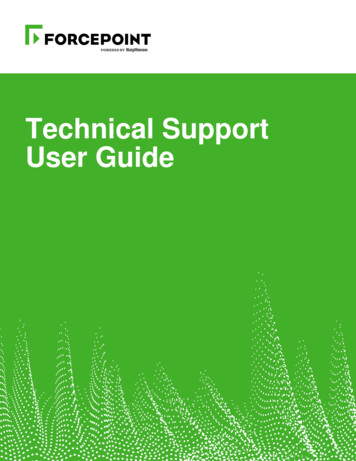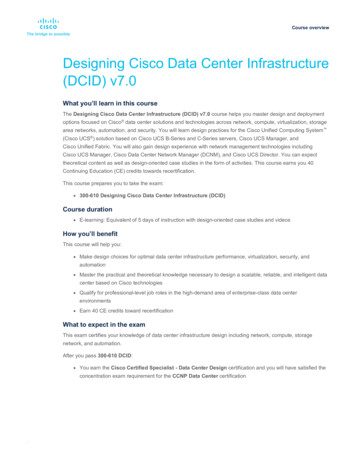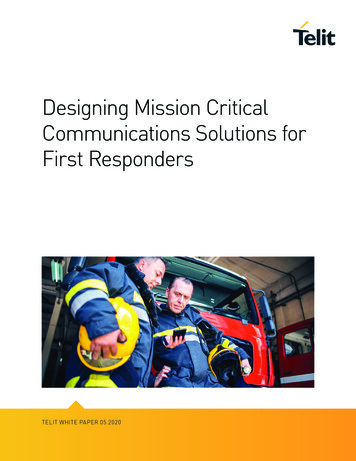
Transcription
Designing Mission CriticalCommunications Solutions forFirst RespondersTELIT WHITE PAPER 05.2020
IntroductionThe First Responders Network — the nationwide public safetycommunications platform dedicated to America’s first responders,was created to provide emergency responders with a high-speed,broadband mobile network dedicated to public safety. Developedby the First Responder Network Authority, this network improvescommunications among first responders. All 50 states and sixterritories have agreed to participate in the initiative.This initiative also creates an incredible business opportunity forcompanies with the expertise to develop robust, interoperable devicesfor use on this network. First responders are looking for devices thatcan straddle current communication protocols and can access Band 14.We are just now getting an understanding of the opportunities thisnew network has created for organizations that develop devices tomeet the needs of first responders. However, we do know one thingfor sure — reliable communication capabilities are and will continueto be essential, especially during these challenging times with thenovel COVID-19 outbreak.ContentsIntroduction2What Is the First Responder Network?3How First Responder NetworkProvides a SignificantMarket Opportunity44 Core Elements of Choosing an IoTPartner for First Responder Devices51. Reliability2. Focus on Quality3. Future-Proof Your Products4. Research and Track Record5566Telit: Because It’s What’s InsideThat Counts7We Connect the World’s Data8Organizations that are searching for an IoT module provider fortheir first responder devices need to ensure that the vendor theychoose can deliver connectivity and reliability. Moreover, the IoTmodule provider must have a track record of success that they canindependently verify.2TELIT WHITEPAPERDesigning Mission Critical Communications Solutions for First Responders
What Is the First Responder Network?Prompted by the tragedy of 9/11, the FCC followed the 911 Commission’s recommendation to create anational public safety network in March 2010. In February 2012, First Responder Network Authority wasauthorized to develop and oversee the dedicated nationwide network for first responders.The First Responder Network is a dedicated broadband communication network for U.S. firstresponders. This network prioritizes communication among first responders in a tiered strategy,ensuring that those responding to an emergency will have uninterrupted communications.In March 2017, the contract was awarded for building out a first responder network leveraging 20 MHzof government spectrum in the 700 MHz band, known in the telecom industry as Band 14. By December2017, all U.S. states and territories had opted in to using the service.This first responder network, which leverages the entire spread of deployed bands in addition toBand 14, is planned to reach more than 99 percent of the U.S. population when completed. The FirstResponder Network will also be an integral part of the 5G rollout with a planned 500 total marketsavailable by the end of 2018. In-building solutions and other coverage enhancements will ensureconstant communications to serve first responders.Identified by their special subscription, the system puts first responders first in line. For instance, therewill often be a traffic jam on the commercial LTE networks in the event of an emergency. However,functionality in the First Responder Network ensures that first responders will always have priority formission-critical communications through their priority features.Communications for first responders on all deployed cellular bands will have priority for emergenciesfrom all agencies who need to respond. Communication traffic can be further prioritized by bumpingnon-responder traffic as bandwidth in the commercial LTE network gets dynamically assigned to firstresponders. For example, in the case of a fire, fire departments and other responders would havepriority, with other network traffic being bumped to a lower speed or service tier.3TELIT WHITEPAPERDesigning Mission Critical Communications Solutions for First Responders
This dedicated LTE network will help overcome the inefficiencies of communication between the 10,000separate, incompatible and often proprietary radio networks currently used by first responders as they tryto talk to each other and coordinate. With this initiative, there’s one dedicated nationwide network for all firstresponders to use.How First Responder Network Provides a SignificantMarket OpportunityFor organizations that develop communication devices, the First Responder Network presents an attractiveand exciting market opportunity. First responders at the national, state and local level will all need devicesand equipment that can access these special services.For organizations that develop communicationdevices, the First Responder Network presentsan attractive and exciting market opportunity.Instead of a private radio network for municipalities, a dual-carrier solution is possible. Regardless ofwhere in the country first responders are located, they are going to have coverage, making it essential forfirst providers to have devices with the ability to access Band 14 and commercial LTE bands for priorityand preemption.The roadmap for the First Responder Network includes mission-critical push-to-talk, voice, data, text, video,broadcast technology and Z-axis location-based services. At the core of these communication solutions willbe modules and data cards robust and reliable enough to meet these needs.4TELIT WHITEPAPERDesigning Mission Critical Communications Solutions for First Responders
4 Core Elements of Choosing an IoT Partner for FirstResponder DevicesOriginal equipment manufacturers (OEMs) that are preparing to take advantage of the First ResponderNetwork capabilities need to think carefully about the solutions they choose when developing theirdevices and applications. Here are the four core elements that OEMs must consider when choosing anIoT partner for first responder communication solutions:1. ReliabilityFor consumers, it can be disruptive when a call drops or an internet connection is lost. The stakesare quite a bit higher for first responders. On the network side, first responder services require 99.99percent broadband service availability. Any service outage should be restored rapidly. Also, the deviceitself needs to perform optimally. First responders need all their equipment to be reliable, which meansthe external product needs to be ruggedized, and what’s inside needs to be robust as well.Look for rugged cellular modules and cards that can operate across a variety of stop/startenvironments. All Telit cellular modules, including the Band 14 products, boast industrial-gradeenvironmental operating temperature ranges of -40 to 85 C and are manufactured for high shock andvibration environments.When developing first responder solutions, OEMs need to choose modules that are built to notonly withstand a variety of environments but also provide reliable speed for mission-criticalcommunications. Reliable speed matters not only for voice but also for video and images, which can bean essential part of first responder communications. For example, imagine the police need to obtain aphoto of a suspect engaged in a hostage situation. If the image takes too long to arrive, the criminal maybe able to slip away before the police can apprehend him.2. Focus on QualityEveryone knows the expression “you get what you pay for.” When working with a limited budget, it’s easyto understand the allure of low-cost modules — but at what cost?What happens when your COVID-19 field medics cannot upload timely patient vitals to the attending ERbecause the cellular broadband connection is being carried by a module that does not support paralleldata carriers aggregated across two different radio bands offered by the supporting mobile network?As a long-standing supplier to the automotive and other quality-gated supply chains, Telit is equippedto handle quality audits across all its departments upon request. We do urge you to make that requestwhen selecting a vendor for your mission-critical communication devices. (Start your quality reviewhere.) We are happy to help you parameterize your quality evaluation criteria for the most criticalcomponent in your cellular first responder product: the cellular module.5TELIT WHITEPAPERDesigning Mission Critical Communications Solutions for First Responders
3. Future-Proof Your ProductsWith 5G in full rollout, OEMs need to design first responder solutions with current and futurecapabilities in mind. New generation data cards, like Telit’s FN980m, will need to go with the NGFF M.2form factor because of speed and latency performance in 5G. Band 14 is available in the new Telit 5G datacard that can operate in LTE mode as a Cat 20 connection supporting up to 2.4 Gbps download speeds (7 CA).4. Research and Track RecordWhen it comes to developing first responder devices, lives may depend on OEMs making the rightchoice for modules. Experienced engineers with decades of experience know how to create modulesthat work. Equipment manufacturers need to choose a module provider with a track record and provenability to create robust, long-life products that you can verify with all mobile networks across America.Moreover, organizations should look for a technology partner dedicated to building “what’s next.”At some point, 5G will be superseded by an even faster network. Even though 5G is set to penetratemarkets this year, telecom companies are already researching “6G.” Module developers need toconstantly look forward to these needs while continuing to innovate to meet the needs of currentlyavailable networks. A provider that is consistently testing its modules with telecom providers ensuresthat your product will always be able to connect.With more than 400 engineers across 4 continents and 12 customer supporting application engineeringhubs distributed around the globe, Telit is focused on continual improvements. We exist to connectthings — even critically important things. That’s all we do. We are in the lab and the field, constantlytesting and upgrading our ability to connect any device, anywhere.With 5G in full rollout, OEMs need to designfirst responder solutions with current and futurecapabilities in mind.6TELIT WHITEPAPERDesigning Mission Critical Communications Solutions for First Responders
Telit: Because It’s What’s Inside That CountsFor OEMs looking to design fully Band-14 capable solutions (modems, etc.), selecting the right data cardor cellular module is the difference between successfully penetrating a new market or watching thecompetition take market share away.There are two types of cellular communication modules with which integrators can design their devices:data cards (e.g., mini-PCIe and NGFF M.2 PC industry form factor standards) and direct-solderableform factors utilizing a land-grid array (LGA) that allows modules to be mounted onto public safetydevices by automated manufacturing systems.Telit’s mPCIe LM960A18 is the first data card capable of speeds more than 1 Gbps over LTE. It’s alsothe first product in industry in the mPCIe form factor to support Cat 18. The rugged LM960A18 deliverssignificant flexibility and a competitive edge for OEMs looking to deploy next-generation productsdelivering carrier broadband-like user experience quickly.The LM960A18 is a sibling product of the Cat 11 LM940, and the two products are fully interchangeable.This versatility provides OEMs the opportunity to create new products based on designs already usingthe LM940 or create product families in different grades of performance-based either on the LM960A18for high end or the LM940 for mid-market.The Telit Band 14-equipped LE910C4-NF LTE Cat 4 and LE910C1-NF LTE Cat 1 are LGA modulesdesigned with public safety and first responder network needs in mind. As they are direct solderable,they require less space and form a more physically robust bond with the public safety device that theyequip, delivering more shock and vibration resistance. The Cat 4 module delivers 150 Mbps and the Cat1, 10 Mbps for download speeds.As the LTE standard evolves and matures, router and gateway OEMs can leverage this technology notonly for high download bandwidth and near instant network response times but also for solid uploadspeeds and reliability as applications like high definition video streaming, digital signage, all-cellularcommercial and enterprise internet, and software-defined wide-area network (SD-WAN) accessbecome more sophisticated.7TELIT WHITEPAPERDesigning Mission Critical Communications Solutions for First Responders
We Connect the World’s DataTelit offers the world’s most comprehensive portfolio of high-performance IoT modules, connectivityservices, and software. Our innovative spirit, decades of experience, deep industry insights and unmatchedIoT technology expertise is the foundation of everything we do.[05.2020]We help customers and partners who require best-in-class performance with our uncompromisingengineering practices and design methodologies that exceed stringent environmental requirements andindustry standards. Our IoT experts have pioneered a successful end-to-end system approach that assuresall pieces work together seamlessly when connecting “things to apps” — from device management toconnectivity and data management and everything in between.Telit reserves all rights to this document and the information contained herein. Products, names, logos and designs described herein may in whole or in part besubject to intellectual property rights. The information contained herein is provided “as is.” No warranty of any kind, either express or implied, is made in relation tothe accuracy, reliability, fitness for a particular purpose or content of this document. This document may be revised by Telit at any time. For most recent documents,please visit www.telit.comCopyright 2020, Telit
when selecting a vendor for your mission-critical communication devices. (Start your quality review here.) We are happy to help you parameterize your quality evaluation criteria for the most critical component in your cellular first responder product: the cellular module. 4 Core Elements of Choosing an IoT Partner for First Responder Devices
